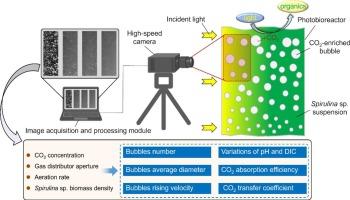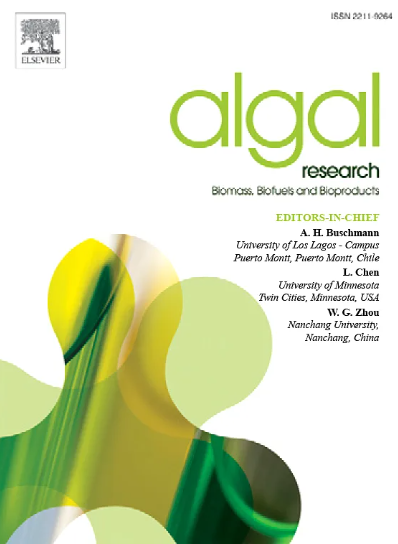Dynamic behavior and transfer characteristics of CO2-enriched bubbles within Spirulina sp. suspension under various aeration conditions using the high-speed imaging technique
IF 4.6
2区 生物学
Q1 BIOTECHNOLOGY & APPLIED MICROBIOLOGY
Algal Research-Biomass Biofuels and Bioproducts
Pub Date : 2024-10-18
DOI:10.1016/j.algal.2024.103758
引用次数: 0
Abstract
The biological CO2 fixation method through microalgae photosynthesis has received considerable attention to alleviate the trend of global warming. CO2-enriched gas is generally aerated into the microalgae suspension in the form of bubbles through the gas distributors. Dynamic behavior and transfer characteristics of CO2-enriched bubbles are crucial to microalgae cells growth and CO2 bio-fixation. A visual experimental system based on the high-speed camera was constructed in this work to obtain the dynamic behavior and transfer characteristics of CO2-enriched bubbles within Spirulina sp. suspension. CO2-enriched bubbles movement and dissolution characteristics were comprehensively investigated under various CO2 concentrations, gas distributor aperture size, aeration rates, and Spirulina sp. biomass densities. Experimental results indicate that the optimal CO2 dissolution mass transfer and absorption rate were attained under the CO2 concentration of 5 %, gas distributor aperture diameter of 10 μm, and aeration rate of 0.1–0.3 vvm. Moreover, as Spirulina sp. biomass density increased, the bubble average diameter decreased, and rising velocity slowed while the volumetric mass transfer coefficient and CO2 absorption rate elevated. To summarize, this work may guide future efforts to enhance the photobioreactors (PBRs) performance from the perspective of aeration conditions optimization.

利用高速成像技术研究不同曝气条件下螺旋藻悬浮液中富含二氧化碳气泡的动态行为和转移特征
通过微藻光合作用固定二氧化碳的生物方法在缓解全球变暖趋势方面受到了广泛关注。富含二氧化碳的气体一般通过气体分配器以气泡的形式充气到微藻悬浮液中。富含二氧化碳的气泡的动态行为和传输特性对微藻细胞生长和二氧化碳生物固定至关重要。为了获得螺旋藻悬浮液中富含 CO2 的气泡的动态行为和传递特性,本研究构建了一个基于高速相机的可视化实验系统。在不同的二氧化碳浓度、气体分配器孔径大小、通气速率和螺旋藻生物量密度条件下,对富含二氧化碳的气泡的运动和溶解特性进行了全面研究。实验结果表明,在二氧化碳浓度为 5%、气体分布器孔径为 10 μm、通气速率为 0.1-0.3 vvm 的条件下,二氧化碳溶解的传质和吸收速率达到最佳。此外,随着螺旋藻生物量密度的增加,气泡平均直径减小,上升速度减慢,而容积传质系数和二氧化碳吸收率升高。总之,这项工作可以指导今后从曝气条件优化的角度提高光生物反应器(PBRs)的性能。
本文章由计算机程序翻译,如有差异,请以英文原文为准。
求助全文
约1分钟内获得全文
求助全文
来源期刊

Algal Research-Biomass Biofuels and Bioproducts
BIOTECHNOLOGY & APPLIED MICROBIOLOGY-
CiteScore
9.40
自引率
7.80%
发文量
332
期刊介绍:
Algal Research is an international phycology journal covering all areas of emerging technologies in algae biology, biomass production, cultivation, harvesting, extraction, bioproducts, biorefinery, engineering, and econometrics. Algae is defined to include cyanobacteria, microalgae, and protists and symbionts of interest in biotechnology. The journal publishes original research and reviews for the following scope: algal biology, including but not exclusive to: phylogeny, biodiversity, molecular traits, metabolic regulation, and genetic engineering, algal cultivation, e.g. phototrophic systems, heterotrophic systems, and mixotrophic systems, algal harvesting and extraction systems, biotechnology to convert algal biomass and components into biofuels and bioproducts, e.g., nutraceuticals, pharmaceuticals, animal feed, plastics, etc. algal products and their economic assessment
 求助内容:
求助内容: 应助结果提醒方式:
应助结果提醒方式:


